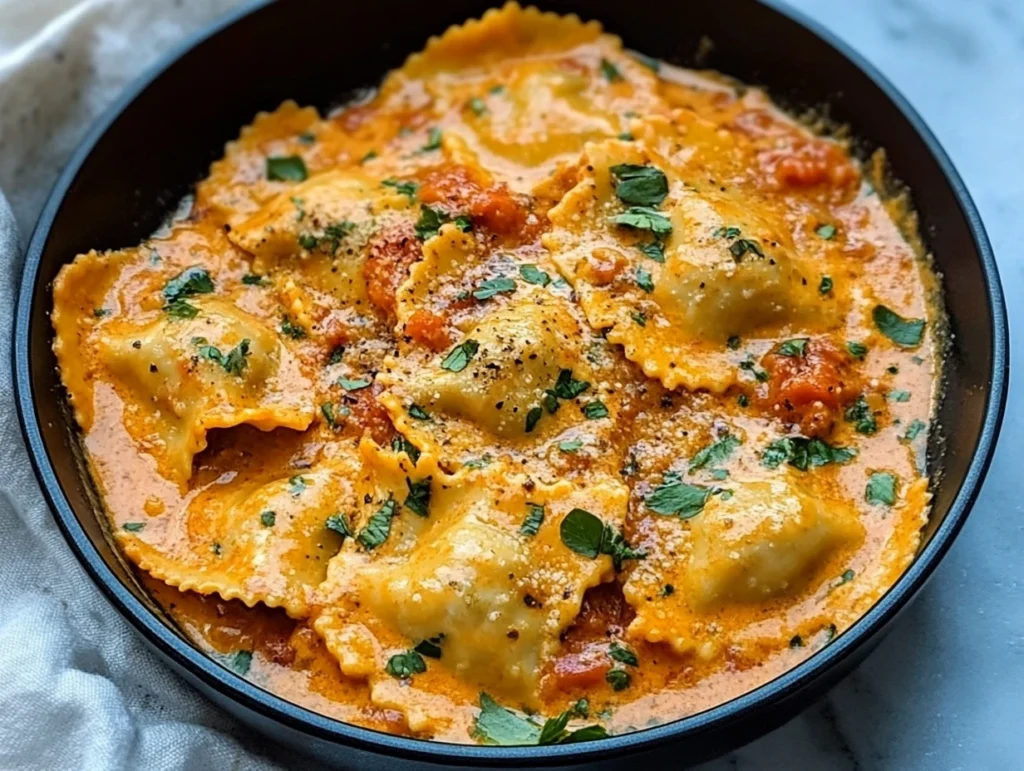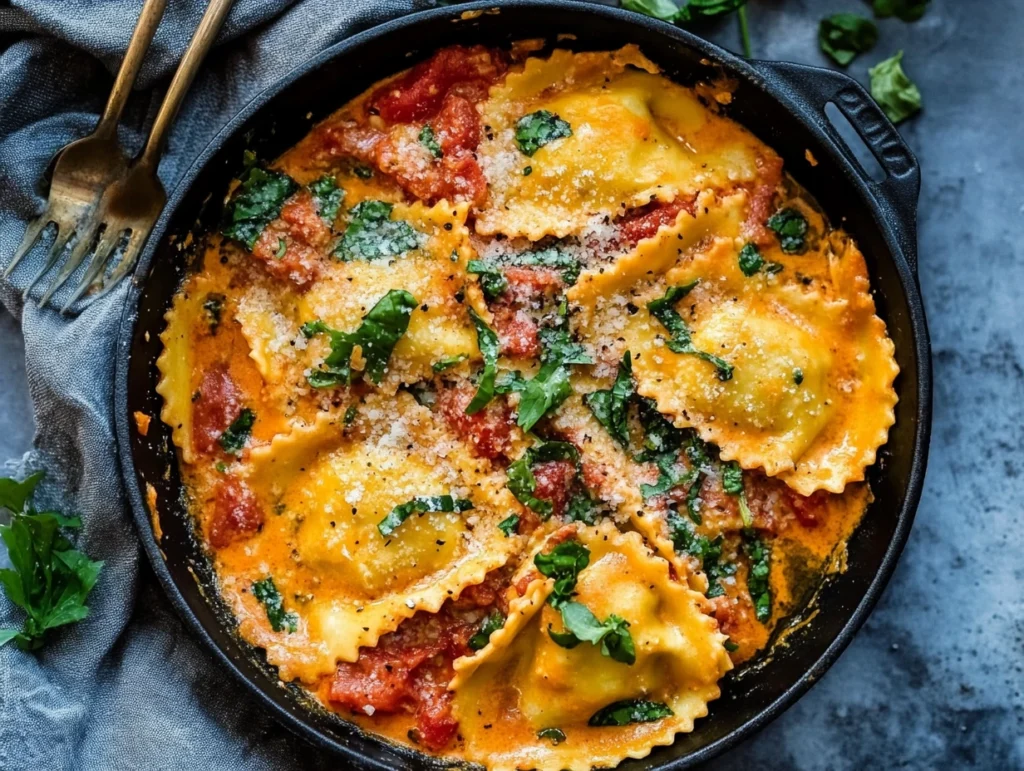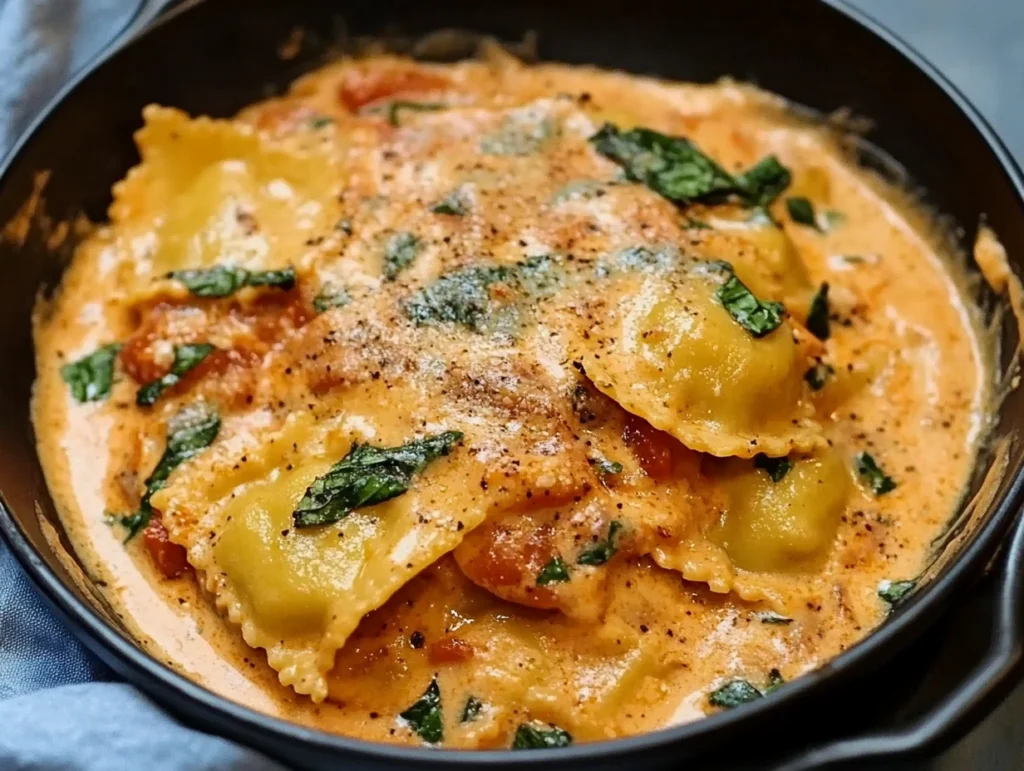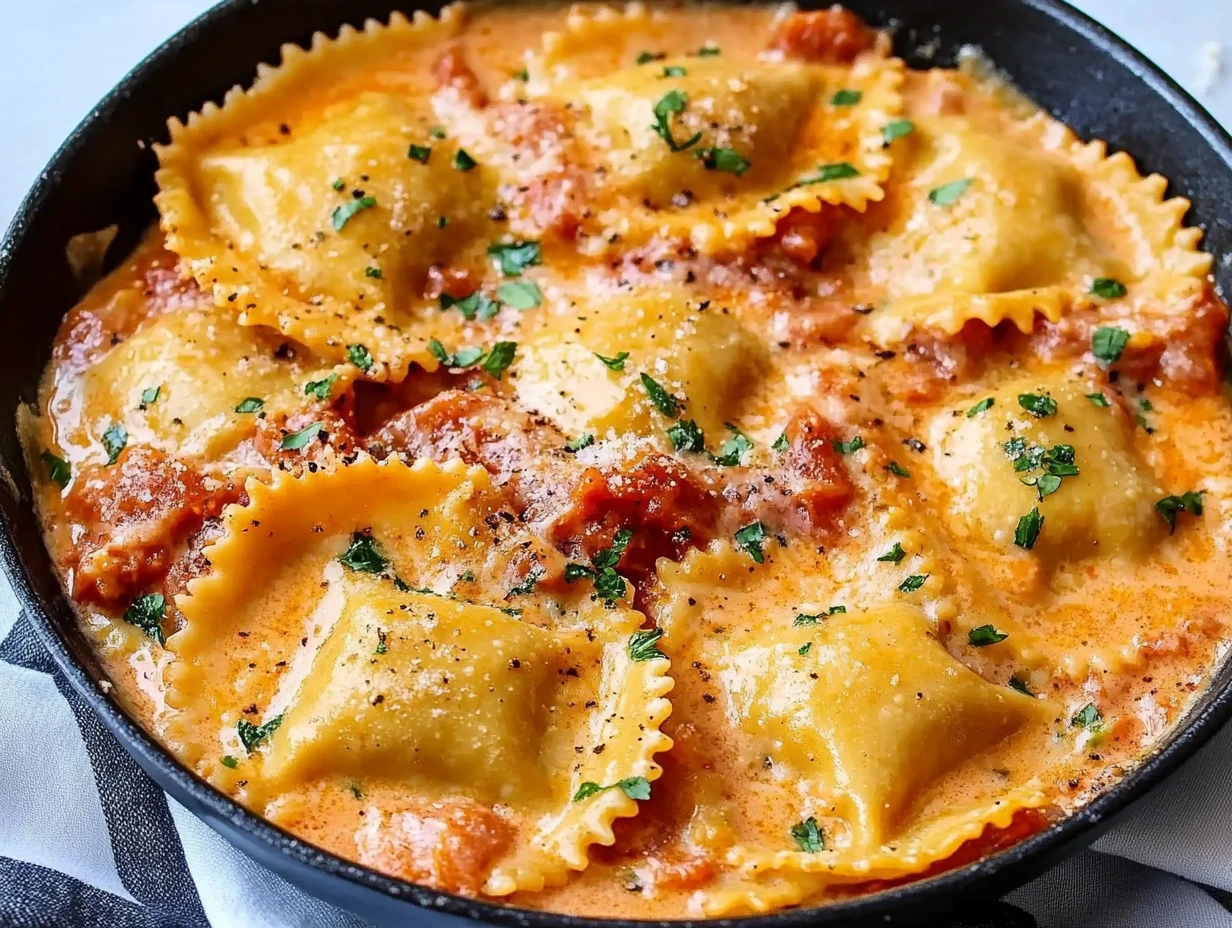Italian cuisine is known for its rich flavors, comforting textures, and heartwarming dishes that bring people together. Among the many beloved Italian dishes, ravioli with tomato cream sauce stands out as a perfect blend of tradition and indulgence. This dish combines delicate, pillow-like pasta filled with savory ingredients, all enveloped in a luscious tomato cream sauce. Whether you’re a pasta enthusiast or simply looking for a dish that satisfies your craving for something creamy, tangy, and utterly delicious, this Italian delight is a must-try.
Table of Contents
The Origins of Ravioli and Tomato Cream Sauce
History of Ravioli in Italian Cuisine
Ravioli has a long and fascinating history in Italian gastronomy. The earliest records of filled pasta date back to the 14th century, when ravioli appeared in cookbooks from the Lombardy and Tuscany regions. Traditionally, these small pasta pockets were filled with a variety of ingredients, such as ricotta cheese, meat, or vegetables, and served in a simple broth or sauce. Over time, ravioli became a staple across Italy, with each region developing its own variations based on local flavors and ingredients.
In Northern Italy, particularly in Piedmont, ravioli is known as “agnolotti”, often stuffed with braised meats. Meanwhile, in Liguria, “ravioli di magro” features a filling of ricotta and greens. As Italian cuisine spread worldwide, ravioli gained popularity beyond Italy, inspiring chefs to create new and exciting fillings and sauces to accompany this classic dish.
Evolution of Tomato Cream Sauce
Tomato-based sauces have been a fundamental part of Italian cooking since the introduction of tomatoes from the Americas in the 16th century. Initially, tomatoes were met with skepticism, but by the 18th century, they had become a beloved ingredient in Italian kitchens. Classic tomato sauces were simple, made with fresh tomatoes, olive oil, garlic, and herbs.
The creamy variation of tomato sauce, often referred to as tomato cream sauce or rosé sauce, is a more modern adaptation. By blending tomatoes with cream, the sauce achieves a perfect balance of acidity and richness. This fusion of flavors makes it an excellent pairing for pasta dishes like ravioli, as the velvety texture enhances the delicate pasta while complementing the filling inside.
Why This Dish is a Must-Try
Perfect Blend of Flavors
One of the biggest reasons to try ravioli with tomato cream sauce is its harmonious combination of flavors. The tanginess of tomatoes, the smooth richness of cream, and the hearty fillings of the ravioli create an irresistible dish. Whether the ravioli is stuffed with cheese, mushrooms, or meat, the creamy tomato sauce enhances its flavor, making every bite delightful.
Versatility in Ingredients
This dish is highly customizable, making it perfect for different tastes and dietary preferences. While traditional cheese-filled ravioli is a popular choice, you can experiment with variations like spinach and ricotta, lobster, or even butternut squash. Additionally, the tomato cream sauce can be adjusted with herbs, garlic, or a touch of spice to suit individual palates. This adaptability ensures that you can enjoy the dish in many different ways.
Ideal for Special Occasions
Ravioli with tomato cream sauce is not just a comforting meal—it’s also a great dish for special occasions. Its rich and elegant presentation makes it perfect for romantic dinners, family gatherings, or holiday celebrations. Served with a side of garlic bread or a glass of wine, this dish can turn an ordinary meal into a memorable dining experience.

Ingredients Needed for Ravioli with Tomato Cream Sauce
To create the perfect ravioli with tomato cream sauce, it’s essential to use fresh, high-quality ingredients. Whether you choose to make ravioli from scratch or use store-bought pasta, a well-balanced sauce and thoughtful additions can elevate the dish.
Essential Ingredients for Homemade Ravioli
Making ravioli from scratch requires a few simple ingredients, but the result is well worth the effort. Here’s what you’ll need:
For the Pasta Dough:
- 2 cups all-purpose flour (or 00 flour for a silkier texture)
- 2 large eggs
- ½ teaspoon salt
- 1 tablespoon olive oil
- 1-2 tablespoons water (if needed, for consistency)
For the Filling:
- 1 cup ricotta cheese
- ½ cup grated Parmesan cheese
- ½ cup finely chopped spinach (optional)
- 1 egg yolk
- Salt and pepper, to taste
- A pinch of nutmeg (optional, for depth of flavor)
Key Components of a Rich Tomato Cream Sauce
A great tomato cream sauce is all about balance—creamy, tangy, and full of depth. Here’s what you’ll need:
- 2 tablespoons olive oil or butter
- 3 cloves garlic, minced
- 1 small onion, finely chopped
- 1 can (14 oz) crushed tomatoes or 3-4 fresh tomatoes, blended
- ½ teaspoon red pepper flakes (optional, for a slight kick)
- 1 teaspoon dried oregano or Italian seasoning
- ½ cup heavy cream
- ¼ cup grated Parmesan cheese
- Salt and pepper, to taste
- Fresh basil or parsley for garnish
Recommended Additions and Variations
- Protein Additions: Add cooked Italian sausage, grilled chicken, or shrimp for extra heartiness.
- Cheese Variations: Mix ricotta with goat cheese or mascarpone for a richer filling.
- Vegetable Enhancements: Mushrooms, roasted bell peppers, or sun-dried tomatoes can add depth to the sauce.
- Spice Boost: A pinch of smoked paprika or cayenne can bring warmth and complexity.
Step-by-Step Recipe for Ravioli with Tomato Cream Sauce
Making Homemade Ravioli from Scratch
- Prepare the Dough:
- On a clean surface, form a mound with the flour and create a well in the center.
- Crack the eggs into the well, add olive oil and salt, and slowly mix with a fork, incorporating the flour little by little.
- Knead the dough for 8-10 minutes until smooth and elastic. Cover with plastic wrap and let it rest for at least 30 minutes.
- Make the Filling:
- In a bowl, combine ricotta, Parmesan, egg yolk, salt, pepper, and nutmeg. Mix well and set aside.
- Roll and Fill the Ravioli:
- Roll out the dough into thin sheets using a pasta roller or rolling pin.
- Place small spoonfuls of filling onto one sheet, leaving space between each.
- Cover with another sheet, press around the filling to seal, and cut into individual ravioli using a knife or ravioli cutter.
- Cook the Ravioli:
- Boil a pot of salted water and cook ravioli for 2-4 minutes, or until they float to the surface. Remove and drain.
Preparing the Tomato Cream Sauce
- Heat olive oil or butter in a pan over medium heat. Sauté onions until translucent, then add garlic and cook for 1 more minute.
- Pour in the crushed tomatoes, season with oregano, salt, and pepper. Simmer for 10 minutes.
- Lower the heat and stir in the heavy cream and Parmesan cheese. Simmer for 2-3 minutes until the sauce is smooth.
- Adjust seasoning if needed and remove from heat.
Cooking and Assembling the Dish
- Gently toss the cooked ravioli in the tomato cream sauce, ensuring each piece is well coated.
- Garnish with fresh basil or parsley and an extra sprinkle of Parmesan.
- Serve immediately with a drizzle of olive oil for added richness.
Pairing Suggestions for the Ultimate Meal
Best Wine Pairings
Pairing ravioli with tomato cream sauce with the right wine can elevate the dining experience. Here are some excellent choices:
- Chianti: A classic Italian red with bright acidity that complements the tomato-based sauce.
- Pinot Grigio: A crisp white wine that balances the richness of the cream.
- Sangiovese: Medium-bodied with hints of cherry and spice, pairing well with the dish’s depth of flavor.
- Rosé: Light and fruity, offering a refreshing contrast to the creamy sauce.
Side Dishes to Complement the Dish
- Garlic Bread or Focaccia: The perfect way to scoop up extra sauce.
- Roasted Vegetables: Try zucchini, bell peppers, or asparagus for a light and healthy side.
- Caesar Salad: A crisp salad with Parmesan and croutons adds freshness to the meal.
- Antipasto Platter: Serve with cured meats, olives, and cheeses for an Italian-inspired appetizer.
Common Mistakes and How to Avoid Them
Even with a straightforward recipe, there are some common mistakes that can affect the quality of your ravioli with tomato cream sauce. Here’s how to avoid them to ensure a perfect dish every time.
Overcooking the Ravioli
One of the biggest mistakes when cooking ravioli is overcooking it, which can make the pasta too soft or cause it to break apart in the water.
How to avoid it:
- Cook ravioli in gently boiling, salted water, not a rapid boil, which can be too rough on the delicate pasta.
- Fresh homemade ravioli usually takes only 2-4 minutes to cook, while store-bought frozen ravioli may take 4-6 minutes.
- Once the ravioli floats to the surface, it’s usually done—drain it immediately to prevent overcooking.
Achieving the Perfect Sauce Consistency
A watery or overly thick sauce can make the dish less enjoyable. If the sauce is too runny, it won’t cling to the ravioli properly. If it’s too thick, it can feel heavy.
How to avoid it:
- Simmer the sauce until it thickens slightly before adding the cream.
- Add cream gradually and adjust as needed. Too much too quickly can make the sauce overly rich.
- If the sauce is too thick, thin it with a splash of reserved pasta water to help it coat the ravioli smoothly.
Balancing Flavors Properly
A perfect tomato cream sauce needs a balance of acidity from the tomatoes, richness from the cream, and depth from seasonings.
How to avoid it:
- If the sauce tastes too acidic, add a pinch of sugar or a little more cream to balance it out.
- Don’t forget to season with salt and pepper—they enhance all the flavors in the dish.
- Fresh basil or parsley can brighten the flavors and keep the dish from feeling too heavy.
Nutritional Breakdown of Ravioli with Tomato Cream Sauce
While ravioli with tomato cream sauce is an indulgent dish, it can still be part of a balanced diet. Here’s a look at its nutritional profile and key health benefits.
Calories and Macronutrient Content (Per serving, approximately 1 cup of ravioli with sauce)
- Calories: ~400-500 kcal
- Carbohydrates: 50-60g (depending on pasta type)
- Protein: 12-18g (varies based on filling)
- Fats: 15-20g (due to cream and cheese)
Ways to make it healthier:
- Use whole wheat or gluten-free ravioli for a higher fiber option.
- Substitute light cream or Greek yogurt instead of heavy cream.
- Add extra vegetables like spinach, mushrooms, or zucchini to increase nutrients.
Health Benefits of Key Ingredients
- Tomatoes – Rich in vitamin C, lycopene, and antioxidants, which support heart health.
- Ricotta cheese – Provides protein and calcium, which are essential for bone health.
- Olive oil – Contains healthy monounsaturated fats that support brain and heart function.
- Garlic & onions – Packed with antioxidants and anti-inflammatory properties.
- Basil & parsley – Help with digestion and provide additional vitamins like K and A.

Variations of Ravioli with Tomato Cream Sauce
One of the best things about ravioli with tomato cream sauce is its versatility. You can easily adapt the recipe to suit dietary preferences, allergies, or personal taste.
Vegetarian and Vegan Options
Vegetarian:
- Stick with classic cheese-filled ravioli or try a mix of spinach, mushrooms, or butternut squash for variety.
Vegan:
- Use dairy-free ravioli filled with cashew ricotta or tofu-based cheese.
- Replace heavy cream with coconut milk or cashew cream for a plant-based creamy sauce.
- Add nutritional yeast for a cheesy flavor without dairy.
Gluten-Free Ravioli Alternatives
Store-bought gluten-free ravioli: Many brands now offer delicious options made with rice flour, chickpea flour, or almond flour.
Homemade gluten-free ravioli:
- Use a mix of gluten-free all-purpose flour and xanthan gum to recreate a soft yet durable pasta dough.
- Substitute zucchini or eggplant slices for the pasta by stuffing them with filling and rolling them up.
Protein-Packed Additions
If you want to boost the protein in your dish, consider these additions:
Meat Additions:
- Add grilled chicken, Italian sausage, or shrimp to complement the creamy sauce.
- Use a meat-filled ravioli, such as beef or chicken, for an extra protein kick.
Legume-Based Protein:
- Use ravioli filled with lentils, chickpeas, or black beans for a plant-based protein source.
Storing and Reheating Tips
Ravioli with tomato cream sauce is best enjoyed fresh, but if you have leftovers, proper storage and reheating techniques can help maintain its texture and flavor.
Best Practices for Refrigeration and Freezing
Refrigeration:
- Store cooked ravioli and sauce separately when possible to prevent the pasta from becoming soggy.
- Place leftovers in an airtight container and refrigerate for up to 3 days.
- If storing together, lightly coat the ravioli with olive oil before adding sauce to prevent sticking.
Freezing:
- Uncooked ravioli: Arrange ravioli in a single layer on a baking sheet, freeze until firm, then transfer to a freezer bag. They can be stored for up to 2 months.
- Cooked ravioli in sauce: Freeze in airtight containers for up to 1 month. However, cream-based sauces may slightly separate upon thawing.
Reheating Methods Without Losing Flavor
Stovetop (Best Method):
- Heat the sauce in a pan over low-medium heat, adding a splash of milk or cream to restore consistency.
- Add the ravioli and gently toss until heated through.
Microwave:
- Place ravioli in a microwave-safe dish, cover with a damp paper towel, and heat in 30-second intervals, stirring in between.
- Add a little water or milk to prevent the sauce from drying out.
Oven:
- Preheat oven to 350°F (175°C) and place ravioli in an oven-safe dish.
- Cover with foil and bake for 10-15 minutes, stirring once halfway through.
Serving Ideas and Plating Tips
Presentation plays a big role in elevating your ravioli dish to a restaurant-quality experience.
Restaurant-Style Plating Techniques
Use a Wide, Shallow Plate:
- This gives the ravioli enough space to stand out while allowing the sauce to be showcased.
Layer the Ravioli Thoughtfully:
- Instead of piling them on top of each other, slightly overlap them in a fanned-out pattern for a refined look.
Sauce Placement:
- Spoon a thin layer of sauce on the plate before adding ravioli, then drizzle extra sauce on top for a clean, artistic presentation.
Garnishing for Extra Flavor
Fresh Herbs:
- Sprinkle chopped basil, parsley, or microgreens for a pop of color and freshness.
Shaved Parmesan or Pecorino Romano:
- Instead of grated cheese, use a vegetable peeler to create delicate cheese shavings for a gourmet touch.
Drizzle of Infused Oil:
- A light drizzle of truffle oil, garlic-infused olive oil, or basil pesto can enhance the dish’s aroma and depth.
Crushed Nuts or Breadcrumbs:
- For added texture, sprinkle toasted pine nuts or crispy breadcrumbs over the ravioli before serving.

Ravioli in Different Cultures
While ravioli is traditionally Italian, many cultures around the world have their own versions of filled pasta or dumplings.
How Different Countries Interpret Ravioli
Italy:
- Traditional ravioli are filled with ricotta and spinach, meat, or seafood and served in broth or sauce.
- Regional variations include agnolotti (Piedmont), tortelli (Lombardy), and cappelletti (Emilia-Romagna).
China:
- Jiaozi (dumplings) and wontons share similarities with ravioli, featuring meat or vegetable fillings wrapped in thin dough.
- Served steamed, boiled, or pan-fried with soy sauce or broth.
Russia:
- Pelmeni are small, round dumplings filled with meat and onions, typically served with butter or sour cream.
Poland:
- Pierogi are filled with potatoes, cheese, mushrooms, or fruit and can be boiled, baked, or fried.
India:
- Modak (a sweet dumpling) and samosas (savory stuffed pastries) are examples of filled dough popular in Indian cuisine.
Similar Dishes Around the World
Maultaschen (Germany):
- Large, ravioli-like pasta filled with spinach, meat, or breadcrumbs, often served in broth.
Empanadas (Spain & Latin America):
- While not boiled like ravioli, empanadas are stuffed pastry pockets, either baked or fried.
Kreplach (Jewish Cuisine):
- These dumplings, similar to ravioli, are filled with meat or potatoes and typically served in soup.
Frequently Asked Questions (FAQs)
Can I use store-bought ravioli?
Yes! Store-bought ravioli is a great time-saving alternative to homemade pasta. It works perfectly with tomato cream sauce, and many brands offer high-quality options with delicious fillings like ricotta and spinach, lobster, or mushroom.
Tips for best results:
- Fresh ravioli cooks in 2-4 minutes, while frozen ravioli may take 4-6 minutes.
- Cook in gently boiling, salted water to prevent them from bursting.
- Drain carefully and toss directly into the sauce for the best texture and flavor absorption.
How do I thicken the sauce without changing the flavor?
If your tomato cream sauce is too thin, there are a few ways to thicken it without altering the taste:
Methods to thicken naturally:
- Simmer longer: Let the sauce reduce over low heat to evaporate excess liquid.
- Use reserved pasta water: A small splash of starchy pasta water can help emulsify the sauce and make it silkier.
- Add a cornstarch slurry: Mix 1 teaspoon of cornstarch with 2 teaspoons of water, then stir it into the sauce.
- Incorporate more Parmesan cheese: This will subtly thicken the sauce while enhancing flavor.
What’s the best way to make this dish dairy-free?
For a dairy-free version of ravioli with tomato cream sauce, swap out dairy ingredients with plant-based alternatives:
Dairy-free substitutions:
- Ravioli filling: Use dairy-free cashew ricotta or a blend of pureed tofu and nutritional yeast.
- Heavy cream: Substitute with coconut milk, cashew cream, or oat-based cream for a creamy texture.
- Parmesan cheese: Replace with nutritional yeast or dairy-free Parmesan alternatives.
How can I prevent my ravioli from bursting?
Ravioli is delicate, and improper cooking can cause them to break apart in boiling water.
How to prevent bursting:
- Use gently boiling water, not a rapid boil—too much movement can tear the pasta.
- Don’t overcrowd the pot—cook ravioli in small batches to prevent them from sticking together.
- Stir gently with a wooden spoon to avoid breaking them.
- If using homemade ravioli, make sure the edges are sealed well before boiling.
Can I prepare the sauce in advance?
Yes! Tomato cream sauce can be made ahead of time and stored for convenience.
Storage tips:
- Store in an airtight container in the refrigerator for up to 3 days.
- For longer storage, freeze the sauce in a freezer-safe container for up to 1 month (though the texture may slightly change).
- Reheat gently over low heat, stirring occasionally. If it thickens too much, add a splash of milk or broth to restore the consistency.
What proteins pair well with this dish?
While ravioli with tomato cream sauce is satisfying on its own, adding protein can enhance the meal.
Great protein pairings:
- Chicken: Grilled or pan-seared chicken breast adds lean protein and soaks up the sauce beautifully.
- Shrimp: Light and slightly sweet, shrimp pairs wonderfully with creamy tomato-based sauces.
- Italian Sausage: Spicy or mild sausage adds a hearty, flavorful touch.
- Beef or Veal: Ground beef or veal works well, especially in meat-filled ravioli.
- Lentils or Chickpeas: For a plant-based protein boost, add cooked lentils or chickpeas to the sauce.
For readers looking to explore more pasta variations, they might enjoy the 10 Bold Cajun Sausage Pasta Recipes, which introduces a spicier, Southern-inspired take on pasta dishes. Those who prefer a creamy and rich pasta might find the Creamy Sausage Pasta Recipe to be a delightful alternative. If you’re considering adding protein to your ravioli dish, exploring Italian Sausage Pasta Recipes & Tips or Chicken Sausage Pasta Tips can provide inspiration for additional flavors.
Conclusion
Ravioli with tomato cream sauce is a true celebration of Italian flavors, combining delicate pasta pockets with a rich, creamy, and tangy sauce. Whether you’re making it from scratch or using store-bought ravioli, this dish is a comforting and satisfying meal that can be easily customized to suit different tastes and dietary preferences.

